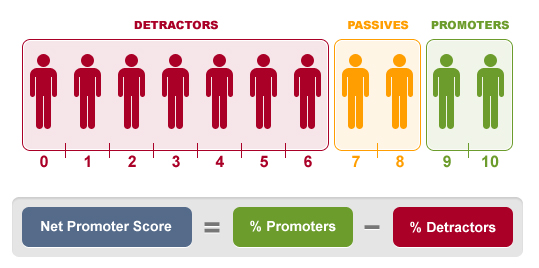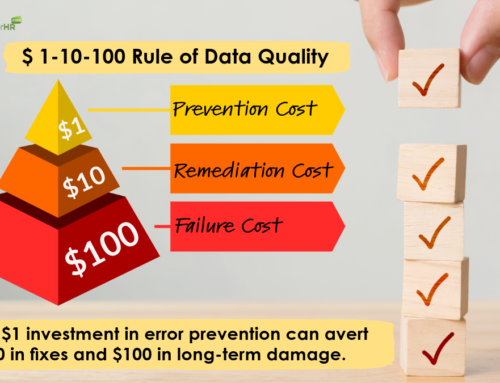This write-up gives a clear insight into how redefining employee survey at each stage of their important lifecycle can be of advantage to the HR Analytics team and overall organization. I usually call these employee satisfaction and engagement survey data as Goldmine data for HR Analytics.
Most organization depend solely on the annual employee survey and they wait for an entire year to know the peak actionable. HR Analytics team works with the limited data set for their prediction and other analytics due to unavailability of granular level data since such surveys are conducted by third-party.
I will begin by differentiating between ‘Employee Satisfaction’ and ‘Engagement’ as many a time there are misconceptions that they both are the same.
- Employee Satisfaction: This measures the employees’ contentment with current job and work conditions which are different from how much effort they are willing to put on either to meet or exceed the goals.
- Employee Engagement: This measures the employee’s self-commitment, how far or at what extent they can go to achieve the goal set by the organization.
It is a well-known fact that Employee Satisfaction leads to Employee Commitment, Employee Commitment leads to Employee Engagement and Employee Engagement turns into Business profitability. Agreed? Furthermore, according to Corporate Executive Board the 10:9 rule states that every 10% improvement in commitment decreases an employee’s probability of departure by 9% while the 10:6:2 rule states that every 10% improvement in commitment increases employee’s effort by 6% and every 6% increase in effort increases employee’s performance by 2%
Furthermore, according to Corporate Executive Board the 10:9 rule states that every 10% improvement in commitment decreases an employee’s probability of departure by 9% while the 10:6:2 rule states that every 10% improvement in commitment increases employee’s effort by 6% and every 6% increase in effort increases employee’s performance by 2%
In addition, Gallup (2012) said that only 30% of employees are engaged at work and Only 45% are satisfied with their job according to the result of the survey conducted by the Conference Board in 2010
You may have noticed, most of the employee’s turnover predictive models exist today don’t even have the individual level survey outcome as one of the influencing factors.
In order to conduct the survey in-house, your HR Analytics team must be empowered to conduct this in the closed and secured environment. This will not only save money for the organization but will also allow them to do better analytics with more factors at the employee level. Please note, your annual survey must always be done by a third party.
Positive Impact of the survey on the organization:
The positive influence of conducting the survey on the organization are as follows:
- The issue can be addressed head-on (Proactive instead of Reactive)
- Ongoing communication with employees will be facilitated
- Gut feelings with employee sentiments and org. health can be confirmed by evidence. This will allow leaders to take right decision
- Employees level data for better prediction
There are many survey tools available in the market which allow you to completely automate the process and does not take a lot of your resource for this purpose. These survey even works on smart devices hence survey can be submitted from anywhere.
As per shrm.org 2016 engagement and satisfaction survey, the following 3 of top 5 contributes to the Job satisfaction: ‘Respectful treatment of all employees at all levels (1) – 67%’, Job Security (4) – 58% Trust between employees and senior management (5) – 55%, Opportunity to use your skill and ability in your work (5) – 55%. Employee Salary holds the 2nd position with 63% and ‘Benefits’ is at 60%. Except for salary and benefit(usually company go with market benchmarking), rest 4 can be addressed without waiting for an annual budget.
The top 5 factors in their order of hierarchical importance and satisfaction from shrm.org survey can be found in the illustration below:
Click here to see the full report from shrm.org
Below is the list of important surveys an organization should conduct for their employees:
New Hire – Onboarding (Within 4-7 days): This enables the organization to understand the employee’s new hire experience which includes Recruiting, Onboarding, Infrastructure and IT Experience etc.
New Hire – (Between 30-45 Days): is rolled out to all employees who have completed either 30 or 45 (post on floor training) days of tenure. This helps the organization to understand their Initial Training, HRBP support, IT support, Application Access, Infrastructure, Work Environment Experience etc. The purpose is to check if the organization has made him/her comfortable in settling in.
New Hire – (After 90 Days): This survey should be sent to all newly joined employees who have been in the organization for at least 90 days. This is to understand their view of Management, Team and Supervisor Support, Goal Assignments, Role Fitment, Infrastructure, HRBP e.t.c. over the last 90 days. The purpose is to check if the employee is comfortable in the production environment.
Quarterly / Half Yearly (All tenured Employees): This survey should be conducted for all tenured employees. The frequency can be decided based on organization health. If your organization is low performing organization then the quarterly survey is preferred to establish frequent communication with the employees or else Half yearly survey should suffice the need.
Exit Survey: This survey allows you to ask the reason for leaving the organization who have left voluntarily. This enables the organization in finding the influencing factors which may have triggered the employee to leave the organization. Sometimes employers do consider having an additional exit survey after 45 to 60 days of leaving the job, especially after their full and final settlement by either calling them or by sending survey link on their personal mail id to find out the real root cause of leaving.
Annual Survey (Take help of External vendor): The annual survey is being conducted by almost all the employers. It is recommended that you conduct this survey with help of a third party organization. This is considered to be more accurate since raw data is not shared with the organization and employees are more vocal.
The organization who feel, online surveys are not possible everywhere. To their information, now almost all survey tools are smartphone compatible and can be easily accessed through Smartphone QR Scanner app or via a link. I would be surprised if any of your team still taking the survey using a paper-based method.
The Survey and its elements:
(1) A closer look at what area to target for the question:
Questions must be customized in line with the type of survey and it should not exceed 15 questions unless it is an annual survey.
- Alignment – with individual employee and company goal
- Communication – If they can openly talk to supervisor, colleague and leadership
- Growth Opportunity – Only for tenured employees
- Compensation/Benefits – To confirm if they are at par with market ratio
- Support for completing the work – Do they get enough support from their team members and supervisor
- Organization future and capability of leadership
- Infrastructure – This should cover IT, Transport, Cafeteria, helpdesk etc.
- Learning and Development – To check, if they get enough support for their learning and development
- Reward and Recognition – To check If the entire process set up by organization is unbiased
- NPS Questions – To check, If you are an employer of choice
- An organization should avoid questions in the survey where they have limited control.
(2) Likert scale:
Most of the survey questions do follow a Likert scale of 1 to 5 where 1 (Strongly Disagree), 2 (Disagree), 3 (Neutral), 4 (Agree), 5(Strongly Agree) however some questions will have Yes/No or True/False type of responses. Some leaders prefer having only 4 scales(exclude Neutral) in case the responses are inclined towards Neutral.
It is also recommended to have an open text field with each of the survey questions so that they can write down the exact issue instead of just giving Disagree or Strongly Disagree rating.
(3) Benchmarking:
Without Benchmarking, the survey results are just another number. This is a key factor that many leaders want to validate against the benchmark set within the organization or industry standard to check whether you are well-ahead or well-behind. In case you don’t have the benchmark data, the leader should look at the previous survey outcome and set a realistic target to achieve.
(4) NPS (Net Promoter Score):
The NPS questions are mostly used to check the willingness of customers to recommend a company’s products or services to others. However, organizations have started adopting it to also check the extent to which the employees are willing to promote their own organization. In most of the cases, employees do rate high on all the tenets. However, if they are not willing to promote their own organization to others and NPS scores are fairly low.
You can ask one NPS question on 0-10 scale in each of the surveys, “I will recommend my organization as an employer of choice”. The calculation for NPS is very simple; you need to subtract the percentage of employees who have rated 9 or 10 (also called promoters) with the percentage of employees who have rated between (0-6). The rating of 7 and 8 are called passive.

Image source: http://telnet.co.nz
The Net Promoter Score varies from -100 to +100. To explain the above formula let’s take an example. Suppose you have 200 respondent in your survey. Of those 200, 100(50%) rated either 9 or 10(promoters) and 40 (20%) have rated 6 or below(detractor) then our NPS Score will be: +30. Please note we do not consider passive raters for this calculation.
(5) Insights, Analytics and Storytelling:
You need a dedicated HR Analytics team, who should be able to do the entire analysis on a regular frequency in a secured environment. For better insight from the data, ensure the mapping of employee’s data such as demographic, D&I, talent profile, learning, performance, Org structure details etc. The entire process can be automated either using existing reporting capability of the survey tool, by developing dashboards in visualization tool or by developing models in statistical tools such as R or Python. For all the verbatim analysis you can use text analytics by using one of data science tool to save time. If your organization has limited number of employees then Microsoft products are good enough to do such analysis.
This is a real ‘Goldmine Data’ for HR Analytics:
HR Analytics team can use the accumulated survey data for doing various analytics including employee sentiment analytics and attrition prediction. Survey data is the most powerful information an HR Analytics team can have if conducted in right way. This not only gives you an idea of changes in the pulse of employees / Team but it also reflects the sentiment for the organization.
This enlightenment topic comes to an end here and I am hoping this may have given you some insights about the importance of having employee surveys at different stages in an organization.
I am looking forward to your feedback in case you like this blog or have any suggestion(s) for improvement.












Good Article Prabhakar, You rightly pointed out most of the organization only dependent on the annual survey. They must start with a survey at each important juncture of an employee to get reality out of the floor and also to feed employee sentiment and feedback for HR Analytics!!
Thanks Ravish!!
Too good Prabhakar… It was long awaited.. have not read a good blog on HR analytics in a long time..you have captured the essence.. Kudos!!
Thanks Pragati!
Productivity of manpower leads to outcome of targeted objective for any Organization. The central point in this whole process is the employee of the Organization and to know him closely is the need of hour. This dynamic area of HR analytics getting more attention by such organizations who want to compete globally and excel in their sector. Thought provoking article. Keep it up Prabhakar ??